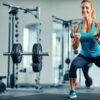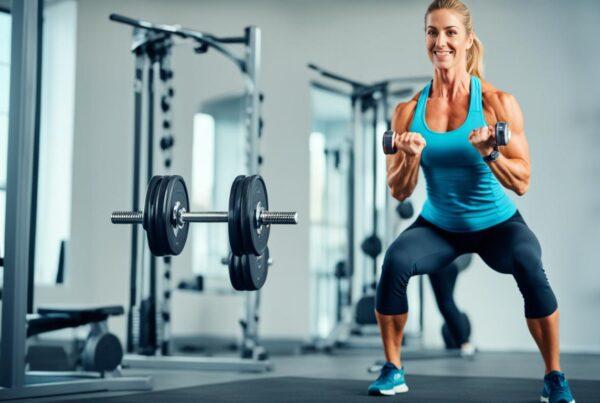If you’re looking to sculpt and define your quads, incorporating isolation exercises into your workout routine is key. Isolation exercises specifically target the quadriceps muscles, helping you maximize muscle definition and achieve the powerful thighs you desire. Not only do strong quads improve knee stability, they also enhance everyday movements and reduce the risk of knee osteoarthritis.
So, if you’re ready to take your quad training to the next level and achieve maximum definition, keep reading. In this article, we’ll explore the importance of quad exercises, the top isolation exercises for quads, and techniques to optimize quad activation for incredible results.
Key Takeaways:
- Isolation exercises target the quads and promote maximum muscle definition.
- Strong quads improve knee stability, everyday movements, and reduce the risk of knee osteoarthritis.
- Include exercises like leg extensions, sissy squats, and single-leg variations in your quad training routine.
- Maintain proper form and focus on the mind-muscle connection for optimal quad activation.
- Progressively overload your workouts to continuously challenge and strengthen your quads.
Why Focus on Quads?
When it comes to building strong and defined legs, the importance of quad exercises cannot be overstated. The quadriceps, commonly known as the quads, are a vital muscle group responsible for knee and hip flexion and extension. Focusing on quad strengthening not only enhances your athletic performance but also provides a range of benefits for everyday movements and overall knee health.
Here are some key reasons why you should prioritize quad exercises:
- Enhanced Athletic Performance: Strong quads contribute to improved power and explosiveness, allowing you to perform at your best in sports and fitness activities. Whether you’re sprinting, jumping, or engaging in any lower body movement, your quads play a critical role in generating force and propelling you forward.
- Improved Knee Stability: Strengthening your quads helps stabilize your knees, reducing the risk of knee injuries during physical activities. By strengthening the muscles that support your knee joints, you can enhance overall joint stability and decrease the strain on ligaments and tendons.
- Easier Everyday Movements: Your quads play a significant role in various day-to-day activities, such as walking, climbing stairs, bending, and sitting down. By strengthening these muscles, you can make these movements easier and more efficient, leading to improved overall functional fitness.
- Prevention of Knee Osteoarthritis: Regular quad exercises can help prevent knee osteoarthritis, a degenerative condition characterized by the breakdown of cartilage in the knee joint. Strengthening the quads helps distribute the load across the joint appropriately, reducing the risk of excessive wear and tear on the cartilage surfaces.
Incorporating quad exercises into your workout routine is essential for maximizing leg strength and overall fitness. By targeting and strengthening this muscle group, you can achieve better athletic performance, improved knee stability, and enhanced functional movements in your daily life.
Top Isolation Exercises for Quads
If you’re looking to target your quads and maximize their growth and definition, incorporating isolation exercises into your workout routine is key. These exercises specifically focus on the quadriceps muscles, helping you achieve the desired results. Here are some of the most effective quad isolation exercises:
1. Leg Extensions
Leg extensions are a classic isolation exercise that directly targets the quads. This exercise is performed using a leg extension machine. Sit on the machine with your back against the pad and adjust the footpad to fit your legs. Begin by extending your legs, focusing on contracting your quads and feeling the tension in the muscles. Slowly return to the starting position and repeat for the desired number of reps.
2. Sissy Squats
Sissy squats are a challenging bodyweight exercise that effectively isolates the quads. Start by standing with your feet shoulder-width apart. Lean backward and lower your knees as close to the ground as possible while maintaining a rigid line from your knees to your head. Engage your quads to stand back up explosively. Sissy squats not only target the quads but also engage your core and improve balance.
3. Single-Leg Variations: Split Squats and Lunges
Single-leg variations like split squats and lunges are excellent exercises to target each quad individually and improve overall leg strength. To perform split squats, stand in a split stance with one foot forward and the other back. Lower your back knee toward the ground, focusing on the quad of the front leg, and then drive through your front foot to stand back up. Lunges involve stepping forward or backward and bending both knees. These exercises engage the quads while also activating the glutes and hamstrings.
It’s important to note that these exercises require proper form and technique to avoid injury. If you’re new to these exercises, consider working with a qualified fitness professional to ensure you’re performing them correctly.
To maximize the effectiveness of these isolation exercises for your quads, focus on muscle contraction, time under tension, and the mind-muscle connection. Engage your quads deliberately throughout each exercise, emphasizing the squeeze at the peak of the movement. This will help activate and stimulate the muscles for optimal growth.
Remember to gradually increase the intensity and resistance as you progress to continue challenging your quads and promoting muscle growth. Consistency and dedication are key to achieving the strong and defined quads you desire. Stay motivated and enjoy the journey!
| Exercise | Main Muscles Targeted |
|---|---|
| Leg Extensions | Quadriceps |
| Sissy Squats | Quadriceps, Core |
| Split Squats | Quadriceps, Glutes, Hamstrings |
| Lunges | Quadriceps, Glutes, Hamstrings |
How to Perform Leg Extensions
Leg extensions are an excellent quad isolation exercise that can be performed using a leg extension machine. To perform leg extensions:
- Sit with your back against the machine.
- Adjust the footpad to fit your legs.
- Extend your legs in a controlled manner while contracting your quads.
- Focus on feeling the tension in your quads throughout the movement.
- Avoid using momentum to ensure maximum quad activation.
By following these steps, you can perform leg extensions with proper technique and effectively target your quads for optimal results.
| Benefits of Leg Extensions | Technique Tips |
|---|---|
|
|
Mastering Sissy Squats
Sissy squats are a challenging bodyweight exercise that targets the quads, builds core strength, and improves balance. Incorporating sissy squats into your leg workout routine can help you achieve stronger and more defined quadriceps muscles.
To perform sissy squats, follow these steps:
- Stand with your feet shoulder-width apart, ensuring proper alignment.
- Lean backward, shifting your bodyweight onto your heels.
- Lower your knees as close to the ground as possible while maintaining a strong and rigid line from your knees to your head.
- Engage your quads and stand back up explosively using your quadriceps as the driving force.
Remember to focus on maintaining proper form and technique throughout the movement to effectively engage the quads.
Here’s an example of proper sissy squat technique:
“Sissy squats have been a game-changer for my leg workouts. I love how they truly isolate and challenge my quads. By leaning back and lowering my knees as close to the ground as possible, I can feel the burn in my quads like never before. Make sure to keep your core engaged and maintain a straight line from your knees to your head. It’s a tough exercise, but the results are worth it!” – Emily, fitness enthusiast
Mastering the technique for sissy squats may take some practice, but with consistency and focus, you can maximize your quad activation and build impressive leg strength. Don’t be discouraged if you struggle initially; over time, you’ll develop the necessary stability and control to perform sissy squats effectively.
Common Mistakes to Avoid
When performing sissy squats, be mindful of these common mistakes:
- Leaning too far back, which can put excessive strain on your lower back.
- Failing to maintain a strong line from your knees to your head, reducing quad engagement.
- Using momentum to stand back up rather than relying on your quadriceps strength.
By avoiding these mistakes and focusing on proper form, you can maximize the benefits of sissy squats and effectively target your quads.
| Mistake | Correction |
|---|---|
| Leaning too far back | Focus on a slight lean while maintaining stability and engaging your core. |
| Poor knee-to-head alignment | Ensure a straight line from your knees to your head throughout the movement. |
| Using momentum | Control the movement and rely on your quad strength to stand back up. |
By mastering the technique for sissy squats and avoiding common mistakes, you can take your quad training to the next level and achieve impressive results.
Maximizing Results with Single-leg Variations
When it comes to targeting your quads effectively, single-leg variations are a game changer. Two of the most effective exercises for isolating and strengthening your quads are split squats and lunges.
To perform split squats, start by standing in a split stance with one foot in front of the other. Lower your back knee towards the ground while keeping your front knee in line with your toes. Drive through your front foot to stand back up. This exercise not only targets your quads but also challenges your balance and stability.
Lunges, on the other hand, involve stepping forward or backward with one leg while bending both knees to lower your body. Push through your front foot to return to the starting position. Lunges are a versatile exercise that can be performed in various directions and angles to target different areas of your quads.
Both split squats and lunges engage your quads individually, allowing you to focus on each leg’s strength and stability. These exercises not only build strong and defined quads but also improve your overall leg strength and functional movement.
Remember, technique plays a crucial role in getting the most out of these exercises. Keep your core engaged, maintain proper alignment, and focus on the mind-muscle connection to maximize quad activation. Gradually increase the resistance or add weights as you get stronger to continue challenging your quads and fuel your progress.
Try incorporating single-leg variations like split squats and lunges into your leg workout routine and witness the incredible results in your quad development.
Benefits of Single-Leg Variations:
- Isolates and targets the quads effectively
- Improves leg strength and stability
- Challenges your balance and coordination
- Enhances functional movement and performance
- Promotes muscle symmetry and prevents imbalances
Sample Workout: Single-Leg Quad Superset
Try incorporating this superset into your leg workout routine to maximize quad activation and strength:
| Exercise | Sets | Reps | Rest |
|---|---|---|---|
| Split Squats | 3 | 10-12 per leg | 60 seconds |
| Walking Lunges | 3 | 12-15 steps per leg | 60 seconds |
Perform each exercise back-to-back with minimal rest between sets. Complete all sets of split squats before moving on to walking lunges. Take a 60-second rest between supersets to recover. Adjust the sets and reps based on your fitness level and gradually increase the resistance as you progress.
Remember, the quality of your technique and the mind-muscle connection are essential for maximizing the results of single-leg variations. Stay focused, push yourself, and enjoy the burn as you work towards stronger, more defined quads.
Enhancing Quad Activation with Mind-Muscle Connection
The mind-muscle connection plays a vital role in optimizing quad activation during isolation exercises. By consciously focusing on contracting and squeezing your quads throughout each exercise, you can enhance the effectiveness of your workout and achieve maximum muscle activation.
To cultivate a strong mind-muscle connection with your quads, it is important to visualize the muscles actively working as you perform the exercises. By mentally engaging with the movement and focusing on feeling the tension specifically in your quads, you can improve the connection between your mind and muscles.
Additionally, maintaining proper form is crucial for stimulating the quads effectively. Align your body correctly and execute each exercise with precision to ensure that the tension is placed primarily on the quads. By avoiding swinging or using momentum, you can isolate and activate the quads more effectively.
The mind-muscle connection can be further strengthened by incorporating techniques such as tempo training and pause reps. By concentrating on slowing down the movement and emphasizing the contraction of your quads during each repetition, you can enhance the mind-muscle connection and promote increased quad activation.
Incorporating these quad activation techniques into your isolation exercises will not only help you feel a greater burn in your quads but also maximize your results. Remember, it’s not just about going through the motions; it’s about truly connecting with your muscles and harnessing their full potential.

Key Takeaways:
- Focusing on the mind-muscle connection during isolation exercises is crucial for optimal quad activation.
- Visualize your quads working and feel the tension in the muscles to enhance the mind-muscle connection.
- Maintain proper form and avoid using momentum to isolate and activate the quads effectively.
- Explore techniques like tempo training and pause reps to further strengthen the mind-muscle connection.
- By cultivating a strong mind-muscle connection, you can maximize your quad activation and achieve better results.
Conclusion
Isolation exercises for quads are the key to achieving sculpted and defined thigh muscles. By incorporating exercises like leg extensions, sissy squats, and single-leg variations into your regular workout routine, you can effectively target your quads and optimize muscle growth. It’s important to focus on performing the exercises with proper technique, engaging the mind-muscle connection, and gradually increasing the intensity to achieve maximum definition and strength in your quads.
Leg extensions are a great exercise to isolate and activate the quads. By using a leg extension machine and maintaining controlled movements, you can feel the tension in your quads and promote muscle growth. Sissy squats, on the other hand, are a challenging bodyweight exercise that not only works the quads but also improves core strength and balance. By maintaining a proper posture and maximizing the range of motion, you can effectively engage your quads during sissy squats.
Incorporating single-leg variations like split squats and lunges into your training routine is another excellent way to target the quads. These exercises challenge each leg individually and enhance overall leg strength. To optimize quad activation, focus on consciously contracting and squeezing the quads throughout each exercise, visualizing the muscles working, and maintaining proper form. Through dedicated quad training and progressive overload, you can achieve the maximum definition, strength, and power in your quads.








